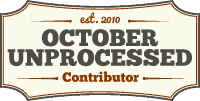
“Did you use non-GMO cornmeal in these scones?" he asked.
“Does Paula Deen put bacon in her cupcakes?" I said, with duh on my face. "Did you know that 85% of corn in the U.S. is genetically modified? But blue corn is still the way nature designed it—not by some guy in a lab coat."
“Well how am I supposed to know if a package of cornmeal has GMO corn when the label doesn't tell me?" he asked. "Don't I have a right to know what's in my food?”
“Here, have one of these righteous blue cornmeal scones full of fresh blueberries, lemon zest, buttermilk and GMO-free love,” I said.
“Mmmm. These are righteous!" he said. "Do I have a right to read the recipe?"
“Hey, I'm all about transparency.”

Blueberry Blue Cornmeal Scones
1 1/4 cups all-purpose flour
3/4 cup blue cornmeal1
1/4 cup cane sugar2
2 tsp. baking powder3
1/4 tsp. baking soda
1/4 tsp. salt
5 TBSP organic salted butter4
1 tsp. (heaping) grated lemon zest
2/3 cup organic buttermilk4
1 cup fresh or frozen blueberries
1 tsp. vanilla
Please see my Breakdown below the directions.
In a medium mixing bowl, stir together flour, cornmeal, sugar, baking powder, baking soda, and salt. Using a pastry blender or two knives, cut in butter until mixture resembles coarse crumbs. Add lemon zest. Make well in center of mixture; add buttermilk, berries, and vanilla. Stir just until moistened.
Turn dough out onto lightly floured surface. Quickly knead dough by folding and pressing gently 10 to 12 strokes or until nearly smooth. Pat or lightly roll dough into 9–12 balls.*
Using a large spoon, drop dough into 9-12 mounds on a large, ungreased baking sheet, leaving 1" between mounds.
Bake in a 400˚ F oven for 20 to 25 minutes or until golden. Remove scones from baking sheet. Serve warm or at room temperature. They will last several days.
* If you’d prefer scone wedges, pat or lightly roll dough into an 8-inch circle on an ungreased baking sheet. Cut into 8 wedges, cutting only about halfway through to score.

Lentil’s Breakdown
1 I got this blue cornmeal from Talon de Gato Farm at the Santa Fe Farmers’ Market, but you can find Arrowhead Mills or Bob’s Red Mill locally. If you want to use yellow cornmeal, make sure it’s organic since organic standards do not allow GMO seeds.
According to Web MD, blue corn is healthier since it’s 20% higher in protein than white corn and contains less starch. The blue color comes from anthocyanins in the corn, which are the same healthy compounds found in berries and red wine.
2 The sugar beet, used to make white granulated sugar, is one of the five main GMO crops in the U.S., and 95% of it is GMO. To avoid this, buy cane sugar, made from sugarcane. Unless it says ‘organic’ or ‘cane,’ it’s almost certainly GMO.
3 Most baking powder has corn starch in it which is GMO, but Rumford uses non-GMO corn.
4 Dairy products may not directly contain GMOs, but if they're not organic, then the animals subsist on a diet of GMO corn.
GMOs have not been tested on humans for long-term health results and have been linked to infertility, serious allergies, weight gain and organ damage in lab animals.

Find out more about California Right to Know Prop 37, volunteer for the campaign or donate to ensure that we win in November.
Related Links:
How to be a Bad-Ass Anti-GMO Activist
Non-GMO Project






































